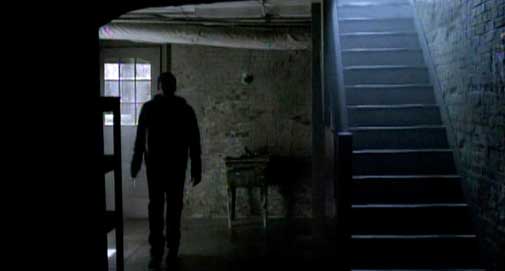
When I first saw the title for FX's American Horror Story, I thought: "Finally. A show about unaffordable health insurance and upside-down mortgages." Somewhat off the mark -- but it's an equally scary idea that introduces us to the troubled Harmon family as it moves into an L.A. mansion that it bought for a song...
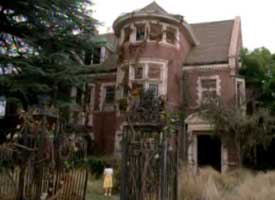
It's not simply a backed-up septic tank that the realtor, obligated by full disclosure laws, must reveal to the Harmons. It's also the recent murder-suicide by the previous owner, who disqualified himself from a feature spread in the "Home of the Week" section by splattering his partner and himself across the basement walls.
Well, who among us hasn't had the albatross of a property around our neck that has driven us to some pretty unstable behavior? I think it was in the vestibule of my last condo building where I started hanging plucked, headless chickens, in part because of paint color choices I couldn't get approved by the condo association.
As Bryan Ferry once sang for Roxy Music: "In every home a heartache." And such is the situation, and new home, in which the Harmons find themselves, replete with the next door daughter, afflicted with Down Syndrome, greeting them on moving-in day with the somewhat non-standard welcome of, "You're going to die in there."
Not exactly the Welcome Wagon and fruit basket.
Or maybe it is. Take away the monsters and creeps in American Horror Story (premiering Wednesday night at 10 ET) and you have a brilliant subtext of weird, nosy neighbors of dubious origin and motivation, and a house full of bad vibes in the walls.
I defy any of us to muse back on our own Haunted Houses and not find our fair share of demons embedded in the walls -- even if they are only in the form of a grim recollection of your little sister swiping your copy of Thriller without asking. (The Michael Jackson album, not the Boris Karloff DVD box set.)
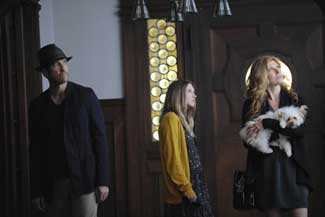
Ben Harmon (fully fleshed out, and fully flawed, by Dylan McDermott,) is an overbearing, self-absorbed psychiatrist, untroubled and dismissive of all the things going bump in the night. Until, that is, he starts to see a few things on his own.
And he has baggage that he's brought with him to, of all places, Fairview Lane. These are in the form of the recent affair he had on the heels of his wife's miscarriage, and also in the form of his cranky teenage daughter Violet (three letters removed from Violence, and played by Taissa Farmiga) -- a sort of living nightmare herself, as every parent knows.
Also in tow is his betrayed wife, Vivian, (another strong character study by Connie Britton) who, despite her inability to find peace with Ben's infidelity and the tragic loss of her child, still sees a dim thread of reconciliation despite her feelings, and is hanging on.
Turns out this haunted house has a Good Wife, too.
It's clear, in a hurry, that the new Harmon home reverberates with the angst of family dramas gone all too wrong with the past occupants.
But we're not totally clear which of these unannounced characters is really there, and which is some kind of apparition visible to only the person seeing them. And even if they are there, are they living?
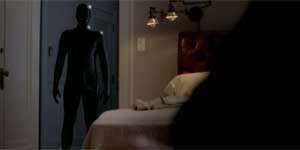
It also becomes apparent that, while Ben mucks around in other people's psyches for a living, he's got a pretty kinky one of his own. Much of the terror in American Horror Story delves deeply into gray areas of psychosexual conflict.
It's the one hot-button conduit into most people's fears, and American Horror Story uses it well.
Horror Story easily is at the top of the list for art direction this year, with great title sequences, quick slashing edits, (suggestive of the other kind of cuts committed by former occupants), and washed-out shots littering the TV screen like the pale corpses littering the history of Fairview Lane.
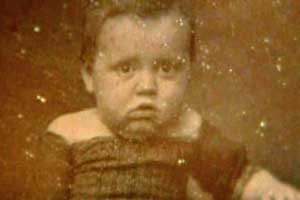
There are flashbacks to things in jars of formaldehyde, bloody clipping shears, and, even more oddly, old photos of children in historic dress, presumably some of the house's former occupants, who never got a decent swing set or hobby horse. For some reason -- perhaps because of the house itself -- there are a lot of birth defects around the story, and the children that do reside there, dead and alive, might be the most frightening of all.
Take that, Mom and Dad.
In keeping with the trend of such shows such as AMC's The Walking Dead and Breaking Bad, there are enough grisly depictions of knife and gunshot wounds and other various pleasantries to keep the realists thoroughly satisfied.
While it may borrow liberally, in tone and noir, from David Lynch's Mulholland Drive, and perhaps M. Night Shyamalan's The Sixth Sense (both are dramas bursting with dark domesticity), that's more of a compliment than a criticism. The haunted house, literally or metaphorically, is a very difficult environment to inhabit and sustain credibly. American Horror Story is the skillful architect of a place you'd be lucky to miss on a realtor's tour.
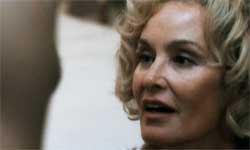
The series features a top-tier supporting cast, including Francis Conroy (Six Feet Under) and Denis O'Hare (True Blood). And then there's Jessica Lange as Constance, perhaps in a warped distant reprisal of her Blanche Dubois from 1996's TV adaptation of A Streetcar Named Desire.
While Blanche was tragic, and held fast to society manners in the face of her angst around her fading youth and desirability, Constance is an elegant Virginia society transplant to LA -- but pretty much batsh*t crazy, and dangerous as a polecat surprised by the porch light on the back deck.
The key question about American Horror Story is whether the Haunted Harmon House can provide a rich enough setting for a regular returning audience, since the plot, the Harmons -- and us viewers -- never leave the house each week.
There are enough surprising twists and turns during the first three episodes, ones that move the action along at such a good clip, that I think the writers of American Horror Story are going to be more than a few steps ahead of us.
Or, in the case of the Harmons, a few slashes ahead.